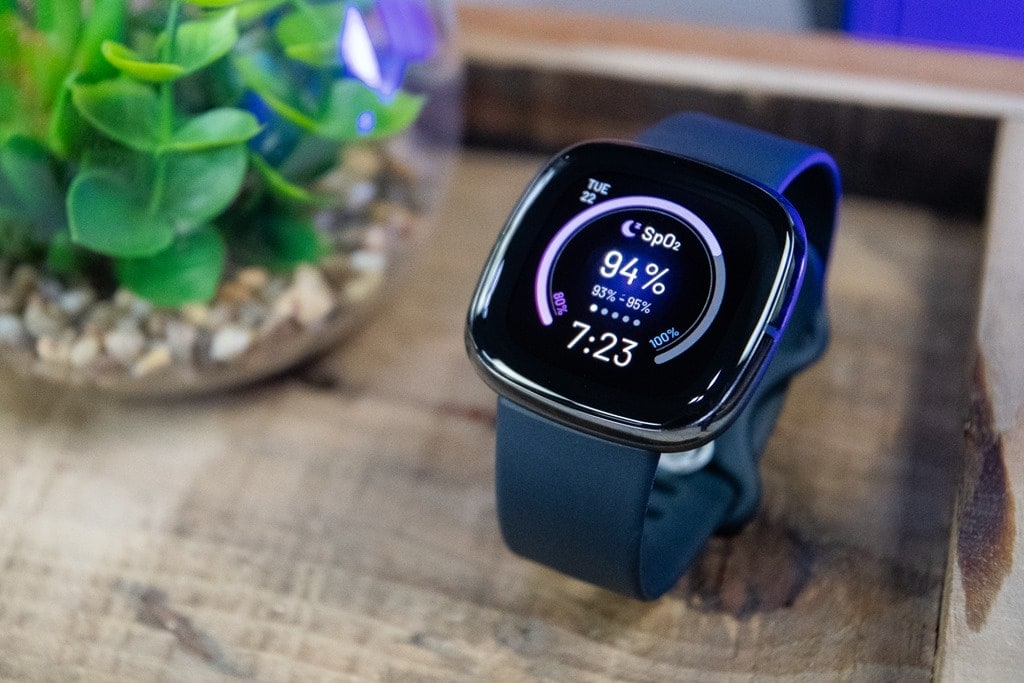These two devices have some common interests but take different approaches in some critical areas. If detailed tracking for health and fitness is your main priority, the Fitbit Sense will probably appeal more to you. On the other hand, if you’re looking for a watch with LTE connectivity that can help you stay in touch at all times, the Samsung Galaxy Watch 3 might be more up your alley.
You won’t find a more advanced health smartwatch than Fitbit Sense.
The Fitbit Sense might look familiar, and that’s because it is almost a mirror image of the Versa watches. You’ll have the Fitbit signature squircle design plus some crucial upgrades that enhance the look and feel of this device. For one, the case on this smartwatch is made of aerospace-grade aluminum and stainless steel. The design also differs from The Versa models because it has a biosensor core that gives off that polished, high-tech appearance. There is only one size and case option for the Fitbit Sense.
While the Fitbit Sense has a familiar look and feel, this model uses the company’s new infinity band system. This means it’ll be easy to find replacement Fitbit Sense bands when the time comes. Fitbit states that the improved design will provide users superior comfort and flexibility. It has a quick-release attachment system that is much easier to use this time. However, it’s worth mentioning that any previous Versa bands you might own won’t work with this new band system.

| Fitbit Sense | Samsung Galaxy Watch 3 (41mm) | |
|---|---|---|
| Display | 1.58″ AMOLED | 1.2-inch AMOLED |
| Dimensions | 40 x 40 x 12mm | 41 x 42.5 x 11.3mm |
| Sensors | ECG, EDA, skin temperature, optical heart rate sensor, SpO2, gyroscope, 3-axis accelerometer, altimeter, ambient light sensor | HRM, ECG, SpO2, accelerometer, gyroscope, barometer, ambient light sensor |
| Connectivity | Bluetooth, Wi-Fi b/g/n | Optional LTE, Bluetooth 5.0, Wi-Fi b/g/n |
| Water-resistance | 5ATM | 5ATM |
| Battery life | 6+ days | 2-3 days |
| Optional LTE | ❌ | ✔️ |
| Onboard GPS | ✔️ | ✔️ |
| ECG | ✔️ | ✔️ |
| EDA | ✔️ | ❌ |
| Skin temperature | ✔️ | ❌ |
| NFC payments | ✔️ | ✔️ |
| Amazon Alexa & Google Assistant | ✔️ | ❌ |
| Mic/Speaker | ✔️ | ✔️ |
The Fitbit Sense has a lot of sensors, which will be a significant selling point for health fanatics. For example, the skin temperature sensor can detect changes that indicate illness, a fever, or a new menstrual phase. It also has an electrocardiogram (ECG) sensor, which will analyze your heart rhythm and detect signs of atrial fibrillation (AFib). You’ll need to hold your fingers on the corners of the watch, stay still for 30 seconds, and receive a reading. The result can be easily downloaded and shared with your physician.
Another brand-new addition is the electrodermal activity (EDA) sensor designed to measure your electrodermal activity responses. All you have to do is place your palm over the face of the watch, and it’ll detect small electrical changes in your skin’s sweat level. This feature can help you better understand how your body reacts to stress.
Fitbit Sense’s new Active Zone Minutes feature helps you reach your personalized target heart rate zones.
Fitbit has rolled out the advanced PurePulse 2.0 technology designed to improve heart-rate monitoring on the Fitbit Sense. The Fitbit Sense personalizes your heart-rate zones based on age and overall fitness level. Fitbit Sense’s new Active Zone Minutes feature helps you reach your personalized target heart rate zones. You’ll also earn — you guessed it — Active Zone Minutes for time spent in the fat burn, cardio, or peak heart-rate zones.
